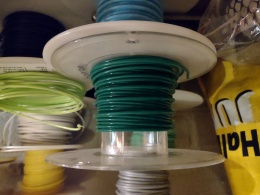Filament Diameter Reducer
| Reducing 2.85 mm filament to 1.75 for use in modern 3D printers. | |
|---|---|
| Participants | |
| Skills | programming (arduino), optimization, construction |
| Status | Info gathering |
| Niche | Printing |
| Purpose | Saving energy and money |
| Tool | No |
| Location | 3D printer Corner |
| Cost | unknown |
| Tool category | Electronics |
Reducing 2.85 mm filament to 1.75 for use in modern 3D printers.
FilaSpool.jpeg {{#if:No | [[Tool Owner::{{{ProjectParticipants}}} | }} {{#if:No | [[Tool Cost::unknown | }}
This project is to transform the current stock of 3mm filament into 1.75mm. The general strategy that I'd like to try out is to run the thick filament through an enlarged extruder, and wind it up at 1.75mm.
To achieve this, the following is required:
1. Extruder set up
Employ a 3mm extruder setup, likely by butchering an existing printer for parts. Enlarge a brass nozzle to 2mm
2. Filament Tensioner / Puller
To reduce the filament to the final diameter, a certain tension is required. For an example of a filament puller, see video below: https://www.youtube.com/watch?v=H6h1yDzoPMU
3. Filament diameter sensor
As the actual tension required likely changes with material, ambient temperature etc, a way to measure and correct the tension is essential. One approach is to use something akin to Thomas Salamanders Infidel filament sensor to accurately measure the outgoing filament diameter. This will allow for a closed-loop control system that governs the puller tension.
4. Construction
Parts identified:

